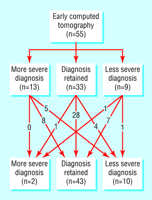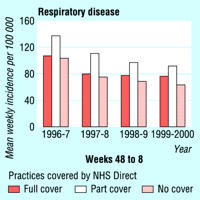This week in the BMJ
Volume 325, Number 7377, Issue of 14 Dec 2002Self help intervention during antenatal care fails to cut smoking
Topical
blockers may cause new airways obstruction
Worldwide gastroschisis epidemic
Early CT improves diagnosis in abdominal pain
Emergency contraception is not an easy choice
Papers with competing interests are less credible
Introduction of NHS Direct did not cause under-reporting of flu
Self help intervention during antenatal care fails to cut smoking
A low cost, self help intervention to stop smoking in pregnancy
was acceptable to midwives and pregnant women, but was ineffective when
implemented during routine antenatal care. A cluster randomised trial
by Moore and colleagues (p 1383) randomised midwives either to
continue to provide pregnant smokers with normal care or additionally to introduce a series of self help booklets to encourage smoking cessation and prevent relapse. Cotinine validated cessation rates were
similar in both trial arms, but substantially lower than the self
reported rates on which current smoking policy is
based.

(Credit: SIPA/REX)
Topical  blockers may cause new airways obstruction
blockers may cause new airways obstruction
In elderly patients without respiratory disease, topical  blockers
used for glaucoma may induce new cases of airway obstruction requiring
treatment. Topical
blockers
used for glaucoma may induce new cases of airway obstruction requiring
treatment. Topical  blockers are known to exacerbate existing
airways disease, but Kirwan et al (p 1396) used the Mediplus database
to compare patients with no diagnosis of airways obstruction who were
given topical
blockers are known to exacerbate existing
airways disease, but Kirwan et al (p 1396) used the Mediplus database
to compare patients with no diagnosis of airways obstruction who were
given topical  blockers for the first time with controls not given
blockers for the first time with controls not given
 blockers. Among 2645 exposed patients the adjusted hazard ratio for
developing airways obstruction at 12 months after the start of
treatment was 2.29 (1.71 to 3.07)
blockers. Among 2645 exposed patients the adjusted hazard ratio for
developing airways obstruction at 12 months after the start of
treatment was 2.29 (1.71 to 3.07) a number needed to harm of 55 patients.
a number needed to harm of 55 patients.
Worldwide gastroschisis epidemic
The prevalence of gastroschisis a congenital malformation of the
abdominal wall
a congenital malformation of the
abdominal wall at birth has increased worldwide. Di Tanna and
colleagues (p 1389) found a substantial rise
at birth has increased worldwide. Di Tanna and
colleagues (p 1389) found a substantial rise from 0.29 to 1.66 per
10 000 population. The authors investigated the prevalence of
gastroschisis among 37 million births in registries from 22 countries
worldwide from 1974 to 1998.
from 0.29 to 1.66 per
10 000 population. The authors investigated the prevalence of
gastroschisis among 37 million births in registries from 22 countries
worldwide from 1974 to 1998.
Early CT improves diagnosis in abdominal pain
Computed tomography of the abdominopelvic region undertaken in patients
with acute abdominal pain soon after admission may reduce inpatient
mortality and length of hospital stay. Ng and colleagues (p 1387)
randomised 120 patients with acute abdominal pain of unknown cause to
early computed tomography or standard practice. The falls in inpatient
mortality and length of stay were not statistically significant, but
early computed tomography missed fewer serious diagnoses than other
standard investigations.

Emergency contraception is not an easy choice
Several factors influence whether young women choose to use emergency
contraception. Free and colleagues (p 1393) carried out in-depth
interviews of 30 women aged 16-25. Those women who expressed the
strongest desire to avoid pregnancy used emergency contraception if
necessary. Women who did not use emergency contraception felt less
vulnerable to pregnancy, had negative associations with emergency
contraception and the people who used it, or found it difficult to seek
or ask for emergency contraception.
"I didn't know where I
was supposed to go and if I was allowed . . . because I
was young, I was like 14"
Papers with competing interests are less credible
When the authors of a research paper declare substantial competing
interests, readers find it less interesting, important, relevant,
valid, and believable than when the authors have no such interests.
Chaudhry et al (p 1391) performed a randomised trial among 300 BMJ readers in which half were sent a short research article
where the (fictitious) authors were employees of a company and held
stock options. The other half received the same article but with
authors who had no such competing interests. On all measures the
readers who received the first version rated it lower than those who
received the second.
Introduction of NHS Direct did not cause under-reporting of flu
Despite media interest, the introduction of NHS Direct had no impact on
consultations for influenza-like illness and other respiratory
infections. Chapman et al (p 1397) compared data
on consultations for respiratory diseases in the winters of 1996-7 and
1999-2000, a period preceding and covering the introduction of NHS
Direct. They found no basis for the claims that an
influenza epidemic had occurred in 1999-2000 but was under-reported
because people were contacting NHS Direct instead of their general
practitioner.
